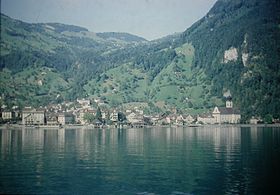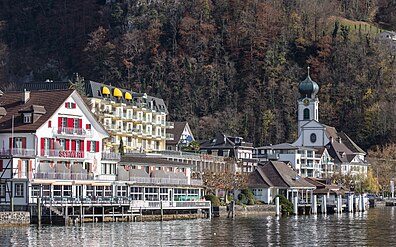Gersau
| Gersau | |
|---|---|
| State : |
|
| Canton : |
|
| District : | Gersau |
| BFS no. : | 1311 |
| Postal code : | 6442 |
| Coordinates : | 682 615 / 205051 |
| Height : | 435 m above sea level M. |
| Height range : | 433–1698 m above sea level M. |
| Area : | 14.36 km² |
| Residents: | 2319 (December 31, 2018) |
| Population density : | 161 inhabitants per km² |
|
Proportion of foreigners : (residents without citizenship ) |
19.4% (December 31, 2,015) |
| Website: | www.gersau.ch |
|
Gersau (1953) |
|
| Location of the municipality | |
Gersau is a municipality in the canton of Schwyz in Switzerland . The community also forms its own district .
geography

Gersau forms a self-contained landscape in a hollow embedded in the sunny and wind-protected Rigisüdhang . Gersau is protected from cool winds by the Rigi-Hochfluh and the Gersauerstock to the north and the Vierwaldstättersee to the south. Hence the particularly mild climate, in which even sweet chestnuts thrive, which is why Gersau is also known in the region as the Riviera of Lake Lucerne .
Above the village at 1550 m above sea level. M. is the Gersau local mountain Rigi Burggeist . This offers a great view of the alpine panorama and Lake Lucerne. An idyllic alpine landscape with a mountain inn, accessible on foot or by cable car.
population
Population development
The population grew sharply between 1768 and 1798 and between 1836 and 1870. In the first growth phase, the high birth surplus was the main reason for this. The settlement of industrial companies (silk spinning and woodworking) were the drivers of the second growth phase (1836–1870: +66.8%). The crisis of these few industrial companies from 1875 onwards resulted in a strong migration to other regions of Switzerland and overseas. Dozens of people from Gersau moved to America by 1883. This was followed by a growth phase for the previously troubled companies. In addition, despite the lack of a rail link, tourism grew due to the construction of roads to Küssnacht and Ingenbohl. Between 1910 and 1930, many jobs in the silk industry were lost and the next wave of emigration occurred. Until 1990 the population remained roughly stable with small fluctuations up and down. Since then, the population has grown steadily (1990–2018: +29.2%).

Population development of Gersau since 1768 Source: Population censuses (1850–2000 Federal), Federal Statistical Office (2010)
languages
Almost the entire population speaks German as the everyday language. In the last census in 2000, 1,753 people (90.64%) said German and 32 people (1.65%) Italian as their main language.
The highly Alemannic Swiss German is slang almost all residents. The language has some peculiarities in common with the neighboring communities in the other Rigi communities and the Schwyz basin.
Religions - denominations
The population used to be fully members of the Roman Catholic Church. The denominational relationships in 2000 still show the original structure despite the mixture: 1494 people were Catholic (77.25%). In addition, there were 6.83% Evangelical Reformed and 3.57% Orthodox Christians, 3.10% Muslims, 0.16% Jews and 4.65% non-religious. 67 people (3.46%) did not provide any information about their creed.
Origin - nationality
Of the 2,319 residents at the end of 2018, 1,764 (76.07%) were Swiss citizens. The majority of the immigrants come from Central Europe (Germany 239, Netherlands 30, Hungary 25, Austria 15 and Poland 14 people), from Southern Europe (Italy 23, Spain 19 and Portugal 18 people), the former Yugoslavia (Bosnia-Herzegovina 20, Serbia 19, Kosovo 14 and Croatia 8 people), Eritrea (19 people) and Syria (10 people). At the 2000 census, 1,622 people (83.87%) were Swiss citizens; 76 of these had dual citizenship.
age structure
The church has a high proportion of middle-aged people. While the proportion of people under the age of twenty makes up 15.91% of the local population, 30.06% are senior citizens (60 years and older). The largest age group is now between 45 and 59 years. The reason for this is the aging of the baby boomer generation (born up to 1965). For every 100 people of working age (20–64 years; 1437 people) there are 26 young people (369 people) and 36 people (513 people) of retirement age.
The current age distribution is shown in the following table:
| Age | 0–6 years | 7-15 years | 16-19 years | 20-29 years | 30–44 years | 45–59 years | 60–79 years | 80 years and more | Residents | ||
| number | 131 | 160 | 78 | 247 | 416 | 590 | 572 | 125 | 2319 | ||
| proportion of | 5.65% | 6.90% | 3.36% | 10.65% | 17.94% | 25.44% | 24.67% | 5.39% | 100% | ||
| Source: Federal Statistical Office, population by age at the end of 2018 | |||||||||||
economy
Historically, silk spinning and woodworking predominated in Gersau. Currently, however, tourism is Gersau's main industry, and since 1860 Gersau has been a well-known health resort and holiday resort with a number of hotels and inns.
The Beckenried – Gersau car ferry runs between Gersau and Beckenried on the opposite side of the lake .
Feckerchilbi in the 19th century
View of Gersau from the opposite side of the lake (above Emmetten )
history
It was first mentioned in the donor register of the Muri monastery in 1064. Since 1332 Gersau was part of the Waldstätten as an independent unit and was mentioned by name in the alliance of IV places in 1359 . In 1390 it was bought out of bailiwick and Habsburg pledging. Who was gersau since 1433 by obtaining Reichsunmittelbarkeit by Emperor Sigismund a nearly 24 square kilometers wide ranging free Republic and facing location of the Confederation (see Republic Gersau ). In 1798 Gersau was assigned to the canton Waldstätte of the Helvetic Republic by Napoleon . After their collapse, Gersau was independent for a few years.
1817 was, however, by a resolution of the Diet connected against his will as the sixth and last district the Canton of Schwyz (on January 1, 1818), resulting in Gersau to the special position of the church, which simultaneously forms its own district. From 1722 to 1817 the Feckerchilbi took place in Gersau every year , which was revived for the first time in recent times in 1982 on the occasion of the celebration of 650 years of the Gersau Republic . A road connection to Brunnen has only existed since 1867, and since 1889 also to Vitznau .
Attractions
- The parish church of St. Marcellus.
- The Mariahilf Chapel, Kindli.
- The old City Hall.
- The Gross-Landammannhaus.
- The Minerva House.
- The majors house.
- The rectory.
- The parishioner's house.
- Villa Flora.
Culinary
Specialties from the Gersau kitchen are Gersau cheesecake and "cream ham", a dessert .
Personalities
- Walter Nigg (1903–1988), theologian
- Josef Maria Camenzind (1904–1984), Catholic clergyman and writer
- Benno Ammann (1904–1986), conductor and composer
- Margrit Camenzind (* 1939), politician (CVP)
- Richard Camenzind (* 1939), Landammann Kt. Schwyz 1998-2008
- Oskar Camenzind (* 1971), professional cyclist, road cycling world champion 1998
- Oliver Camenzind (* 1972), football player (1992 cup win with FC Luzern )
literature
- Linus Birchler : The art monuments of the canton Schwyz, Volume II: The districts Gersau, Küssnacht and Schwyz. Art historical overview. (= Swiss art monuments. Volume 2). Edited by the Society for Swiss Art History GSK. Bern 1930.
- Albert Müller: Gersau - unique in Swiss history. here + now, Baden 2013, ISBN 978-3-03919-263-2 .
Web links
- Official website of the district and the community of Gersau
- Albert Müller: Gersau. In: Historical Lexicon of Switzerland .
Individual evidence
- ↑ Permanent and non-permanent resident population by year, canton, district, municipality, population type and gender (permanent resident population). In: bfs. admin.ch . Federal Statistical Office (FSO), August 31, 2019, accessed on December 22, 2019 .
- ↑ Archived copy ( Memento of the original dated May 4, 2016 in the Internet Archive ) Info: The archive link was inserted automatically and has not yet been checked. Please check the original and archive link according to the instructions and then remove this notice.
- ↑ Michael Tomaschett: The parish church of St. Marcellus in Gersau. (Swiss Art Guide, No. 936, Series 94). Ed. Society for Swiss Art History GSK. Bern 2013, ISBN 978-3-03797-118-5 .









